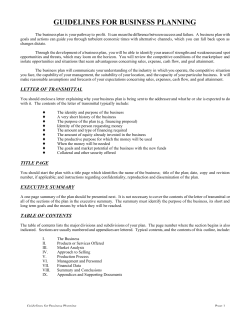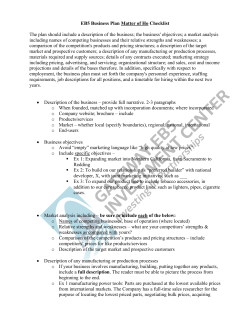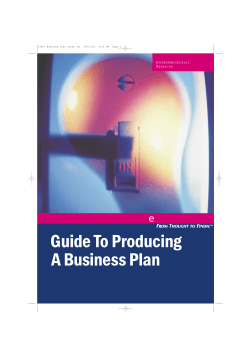
The Business Plan 2012
The Business Plan 2012 Page 1 of 6, see disclaimer on final page The Business Plan What is a business plan? Essentially, a business plan is the management and financial blueprint of your company. It is meant to serve as both your business guide and as a tool with which you will, hopefully, attract investors. The plan must be comprehensive yet concise. It should explain the characteristics of your business, as well as discuss how the business will be financed and managed and how the business will function in its target market. There is no limit to the length of a plan, though the average is probably under 50 pages. Your plan should be separated into sections, such as business, marketing, financial, and "supporting documents." You can also include a cover sheet and an executive summary. Before you begin writing, however, it is probably a good idea to consult an attorney and/or an accountant with experience in business-plan preparation. The following are brief descriptions of the sections generally found in a business plan. Cover sheet The cover sheet is simply a title page for your business plan. It should contain identifying information such as the name of the company, its address, phone number, owners' names and addresses, and the date on which the plan was distributed. Executive summary The executive summary (or the statement of purpose) is, broadly, a summary of your business plan. In no more than a page you should describe the nature of your business and the reason why the reader has received a copy of your business plan. It is here that you either enthrall or bore your reader. This is an opportunity to let the reader know why your business is such a great idea and why he or she should continue reading. Because the reader is most likely a potential investor, you will need to briefly explain why you need the funds you seek, how they will be used and, if the reader is a lender, how and when you intend to repay. Don't forget to attach supporting documents in the "supporting documents" section of your plan. These documents may include, for example, estimates of the items you might intend to purchase with the funds sought. Business This is the first major section of your business plan. It should contain a more detailed description of your business. You should begin with a brief (one page) summary that will address the key elements of your business. The remainder of the section should address each of these key elements more specifically. Your business's key elements might include the following: Legal structure (your choice of entity) What entity did you choose and why? Don't forget to include supporting documentation (for instance, the partnership agreement if you chose the partnership form). For more information on choosing an entity, see that separate discussion. Business and industry description Describe your business in greater detail: assets and liabilities; past, current, and future (projected) financial status. You should also include information about the industry in which your business will operate and its trends. Your product or service Describe in detail the product sold or service rendered. If you are producing a product, explain how the product is manufactured. What are the raw materials required? Who are your suppliers? What are the costs of production? If 2012 Page 2 of 6, see disclaimer on final page your business is providing a service, what is your service and why is it unique? Why, how, and where will it be provided? In this section, you will also address anticipated problems and how they will be resolved. It includes best-case, realistic, and worst-case scenarios. For example, if your business is successful, how will you address a rapid increase in orders for your product? Where will you get the additional financing for production? Again, if you have supporting documents, attach them. Your business location Provide the address and attach pictures or maps if available. In addition, explain why you chose the location, its history, its significance relative to your target market, and other factors, including: • Accessibility to customers/suppliers • Availability of parking/labor/housing/raw materials/supplies • Area crime rate • Quality of utilities and public services (e.g., police) • Taxes • Local business climate • Zoning regulations • Alternate sites for the business Management/employee information Explain who will be employed by, and who will manage, the business. What are their job descriptions? Why were they chosen? What is the extent of their education and their work experience? Attach their resumes. Accounting system Here you will need to describe the accounting method chosen and the reasons for the choice. You should describe the person(s) who will be responsible for keeping accounting records. Are they skilled? Will they be employees or independent contractors? Who will be responsible within the company for analyzing these records or financial statements and implementing the changes they may suggest? Be thorough. This section can inject investors with either confidence or doubt. Other Feel free to add whatever other elements you deem necessary such as insurance or security information. Marketing The marketing section of your business plan will likely be the most time-consuming, though probably the most influential. In this section you must discuss your target market as well as the larger market within which it exists. Who will purchase your product or service? Why will they choose your company and how will they be informed of it? As with the business section, begin your marketing section with a summary of the key points you intend to make, then talk about those points in detail in the body of the section. Again, support your discussion. Include any marketing data you've collected in the "supporting documents" section. In your marketing section you might discuss the following key points. Industry trends and your target market Describe the market research you conducted, the resources used, and the results obtained. Discuss the industry and its trends, especially those that suggest that your product or service will be successful. Then develop a more detailed discussion about your target market. Whom does it encompass? What are its demographics? How will you 2012 Page 3 of 6, see disclaimer on final page penetrate and serve this market? Where do the customers within this market live/work/shop? How will you get your product or service to those who need it? Don't exaggerate. Be reasonable! Support your research and the inferences drawn therefrom with reports from the U.S. Census Bureau, questionnaires, and other marketing test results. Advertising Now that you know your target market, you will be prepared to communicate with potential customers and inform them of your product or service. Discern what magazines they read, the television they watch, and the radio stations they listen to. Then ascertain the level of advertising in which your competitors engage within these various media. Describe within this section, among other things, the methods of advertising chosen, the reasons for your choices, how and when your message will reach your target market, and the cost of all advertising. Again, support your conclusions. Include promotional materials, flyers, and pamphlets. Competition There are generally two types of competition: direct and indirect. Direct competition involves competitors that offer the same product or service to the same market that you have targeted. Indirect competition, on the other hand, involves competitors that may offer the same product or service, but that cater to a market different from your target market. You will need to discuss both types of competitors. Further, you should be able to answer certain questions. Where are your competitors located? How do you plan to compete? Can you serve the market better than your direct competitors, and if so, how? How much market share do your competitors have? How much do you intend to acquire? Will you acquire your share of the market from your competitors, or will you tap a hidden portion of the market? Other You may include other relevant elements in your marketing section, such as pricing, product design, location, or regulatory restrictions. Financial In the financial section you will report your company's past and current financial performance as well as projections for the future. This section should include a summary of your financial needs in which you briefly outline how much money you need and why, and various financial statements (among other things). Though some investors will require more or less information, it is most important that the financial information provided is accurate and well supported with documentation. Some of the financial statements you might need to develop include a cash flow statement, projection statement, break-even analysis, balance sheet, and profit and loss (P & L) statement. Cash flow statement The cash flow statement presents the sources and uses of cash generated from business operations. It should include monthly projections for the following year and be updated to reflect actual performance. If your company has been in business for some time, you can use past and current figures to generate predictions. If you are just starting your business, you will have to project all of your financial needs. Regardless, your cash flow statement should identify two things: (1) when and how much cash will be received, and (2) when and how much cash will be disbursed to pay expenses. In addition to informing investors, your cash flow statement permits you to identify sources of cash (e.g., debt, equity, and profits). The cash flow statement is often referred to as the Statement of Changes in Financial Position. Projection statement Unlike the cash flow statement, which includes all sources and uses of cash, a projection statement includes only income and business expenses for a period of time--three to five years, for example. The period of time covered and whether the statement should be developed on a monthly or annual basis will depend on the intended use of the statement. If, for example, a lender will be reading the statement, you should probably accommodate his or her preferences on statement preparation. Or, if the statement is solely for your personal use, it can be developed on a monthly basis for a period of years. Potential sources of information for your projection statement include past financial statements, current cash flow statement, sales forecasts, and the business and marketing sections of your business plan. 2012 Page 4 of 6, see disclaimer on final page Break-even analysis Using the figures in your projection statement (e.g., sales revenue, fixed and variable costs), you will mathematically or graphically calculate your business's break-even point--the point at which your business will neither turn a profit or incur a loss. The analysis is a prediction of when your business will begin to earn profits. Balance sheet A balance sheet is like a photograph of your business's financial health at a particular point in time, such as the end of an accounting period. The balance sheet contains three categories: (1) assets--all those things of value owned by your business, (2) liabilities--all the debts your business owes, and (3) net worth or capital--the owners' equity in the business. A simple mathematical equation will show the relationship between these three categories: Net Worth = Assets minusLiabilities The balance sheet is a good measure of your business's financial health and can be a useful indicator of what business changes are needed, if any. Profit and loss statement The profit and loss statement (P & L) is similar to the balance sheet in that it reflects your business's financial health. Unlike the still photograph of a balance sheet, the profit and loss statement usually covers your business's tax year. The P & L is generally separated into several categories: (1) income, (2) expenses, (3) income from operations, (4) pretax net profit (or loss), (5) income taxes, and (6) post-tax net profit. The statement is especially effective in helping you determine your business's financial strengths and weaknesses. For example, a review of your profit and loss statement may show that money spent on a particular activity has not generated the revenue anticipated and should therefore be terminated. 2012 Page 5 of 6, see disclaimer on final page IMPORTANT DISCLOSURES Broadridge Investor Communication Solutions, Inc. does not provide investment, tax, or legal advice. The information presented here is not specific to any individual's personal circumstances. To the extent that this material concerns tax matters, it is not intended or written to be used, and cannot be used, by a taxpayer for the purpose of avoiding penalties that may be imposed by law. Each taxpayer should seek independent advice from a tax professional based on his or her individual circumstances. These materials are provided for general information and educational purposes based upon publicly available information from sources believed to be reliable—we cannot assure the accuracy or completeness of these materials. The information in these materials may change at any time and without notice. Page 6 of 6 2012 Prepared by Broadridge Investor Communication Solutions, Inc. Copyright 2012
© Copyright 2025




![-- FREE VERSION -- BUSINESS PLAN [Company Logo]](http://cdn1.abcdocz.com/store/data/000167608_1-42df28f9b0d5f3010b555b6dd3118db4-250x500.png)







![[PEARCEY AWARDS PITCHING COMPETITION] 1](http://cdn1.abcdocz.com/store/data/000370564_1-40ec91c2cf93e9f4bbe91077e0724438-250x500.png)








